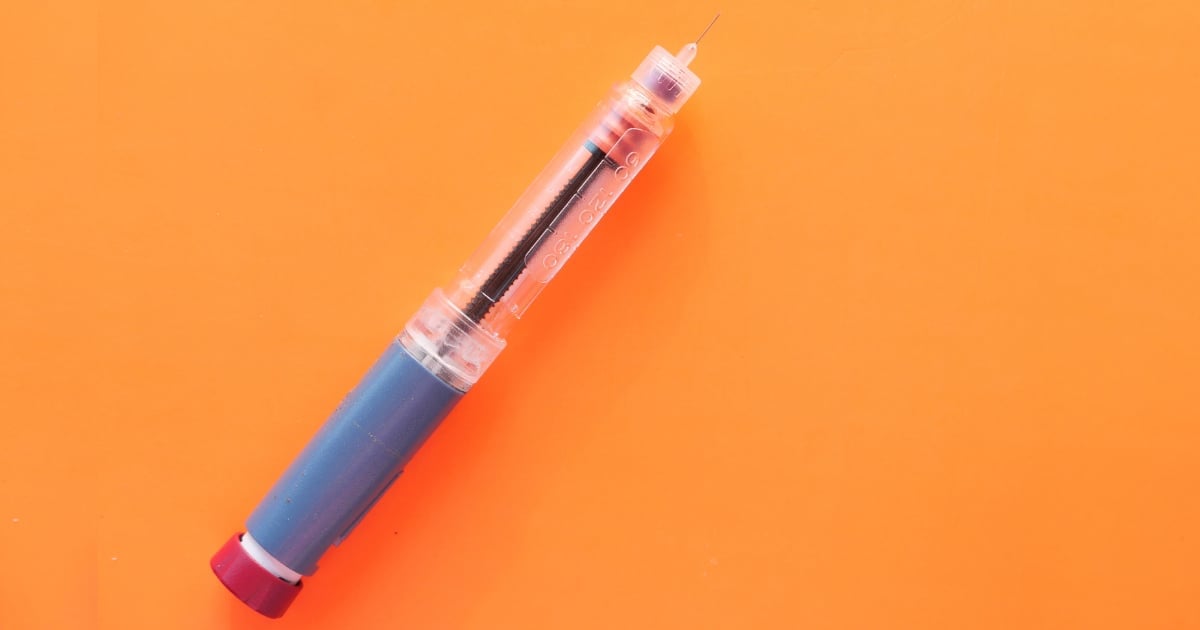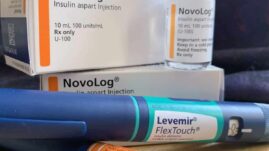Anyone who lives with insulin-dependent diabetes knows that management requires insulin injections and a lot of them.
Insulin injections are meant to be taken subcutaneously, so the medicine can quickly be absorbed into the fatty tissue directly under the skin, but sometimes one can benefit from injecting insulin into muscle.
This article will outline the do’s and don’ts of injecting insulin into muscle.

How is insulin normally injected?
Insulin is typically injected subcutaneously, meaning into the layer of fatty tissue underneath the skin. This provides for a predictable release of the medication, more painless shots, and less injection site bruising overall.
Today’s super small syringes and insulin infusion sets make injecting insulin easier than ever. When injected into fatty tissue, like around the stomach, arms, buttocks, or legs, most of today’s rapid-acting insulins will start working within 10-15 minutes and can stay in the body for up to 4 hours.
Why would someone inject insulin into a muscle?
Someone may inject insulin into a muscle by accident, or because they simply do not have a lot of fatty tissue on their body.
Sometimes people feel as if they’ve “run out” of injection sites, and inject into muscle out of necessity, or other times they simply want their insulin to work faster.
Injecting into muscle can be more painful, so be careful of how often you do this. Injecting into muscle will also hasten the absorption of an insulin dose, the caveat being that the insulin will also be metabolized and out of your system faster, too.
Injecting into muscle can be helpful if you are eating something with a lot of added sugar (that will raise your blood sugar much more quickly), and you need your insulin to kick in faster.
Is injecting into muscle safe?
While generally safe, you’ll need to beware of post-prandial (after meal) high blood sugars, since the insulin will have a shorter tail on the backend.
It is never recommended to inject long-acting insulin into muscle, as the mechanism of action for longer-acting insulins will not work appropriately if not injected into fatty tissue. Injecting shorter-acting insulins (like Humalog or Novolog) is generally fine. Although always check with your doctor first.
While it is not recommended to always inject insulin into muscle (it’s subcutaneous for a reason), injecting into muscle in a pinch can be a fine thing to do.
What to do (and not do!) if injecting insulin into muscle
Do not inject long-acting insulin into muscle
Doing so can alter the effects of your long-acting insulin, wreaking havoc on blood sugars for 24 hours or more. Always inject long-acting insulin into fatty tissue.
Do not inject into muscle regularly
Injecting into muscle can cause more bruising, is more painful, and insulin is not properly absorbed (it’s absorbed much faster and is metabolized and out of the body much faster, too).
If you need your insulin to work better with the food you’re taking, try injecting 15-20 minutes before you start eating and see if that helps, instead.
Do try injecting into muscle if you have stubborn high blood sugar
Sometimes using this technique to get your blood sugars down faster is useful, especially when you’re sick and at risk for diabetic ketoacidosis (DKA).
Injecting into a muscle to make your blood sugar lower faster before a big event like a school exam, movie outing, or family dinner can also help in a pinch.
Always talk with your doctor before doing so, though, and especially if you’re sick and experiencing chronic high blood sugars of over 250 mg/dL with moderate or high ketones for several hours.
In this case, you may need to seek emergency medical attention in the form of an IV insulin drip at a local hospital.
Do continue to use alcohol swabs and clean syringes
As always, to prevent infection, always use a fresh alcohol swab and clean syringe/pen when taking any injection. People with diabetes are at higher risk for infections in general, and this is an incredibly easy step towards preventing an unwanted hospital stay!
Do rotate your injection sites
Sometimes people with insulin-dependent diabetes simply feel as though they’ve “run out” of room for new injection sites. This is where injecting into a muscle occasionally can make sense.
Make sure you’re rotating your site appropriately, and not overusing any one area, as that can cause scar tissue and insulin resistance.
Do inject into a muscle if you’ve forgotten to bolus for a meal
Anyone knows that forgetting to bolus for carbohydrates eaten at a meal can mean trouble. Injecting into a muscle can get your insulin working much faster than taking a regular injection into fatty tissue, so this tactic can be used if you’ve forgotten to dose.
Work with your doctor to see if this can be helpful for you.
Do carry extra low-snacks with you when injecting into a muscle
Due to insulin acting much faster when injected into a muscle, make sure to carry plenty of low-snacks with you if you’re on the go, as you may need to treat some unexpected hypoglycemia.
Make sure to keep an extra close watch on your blood sugars for several hours after injecting into a muscle as well, as the unpredictability of the mechanism of action may cause you some blood sugar rollercoasters.
Do try inhalable insulin
If you frequently suffer from stubborn high blood sugars or regularly forget your meal bolus, ask your doctor about trying Afreeza, the inhalable insulin, which starts lowering blood sugar after only about 12 minutes.
This works much faster than some injections while hurting a lot less than taking a syringe to a muscle.
Always work with your doctor
However you may inject insulin, whether manually with multiple daily shots or through an insulin pump, you should work with your doctor or endocrinologist to figure out what will work best for you and your lifestyle.
Knowing that injecting into muscle occasionally is an option can help you curb stubborn high blood sugars, manage more difficult-to-dose-for meals, and prevent scar tissue in high-use areas for shots, but it does have its downsides.
Injecting insulin into muscle changes the way it’s metabolized, can be more painful, and may cause more bruising. And be careful to never inject long-acting insulin into muscle, as that can ruin blood sugars and send you on a blood glucose rollercoaster for the next 24 hours.
With these strategies, hopefully, you will find yourself more equipped if and when you need to inject insulin into a muscle.




Francesca Payge
Hi Christine, I’ve just been told after 22 years (type one) that injecting into muscle slows down insulin uptake. Is this true or does it speed up uptake OR is there a middle ground (ish)?
I’m a very active tennis nerd, horsey girl and gym user for 3-5 hours a day, six days a week?
Christel Oerum
It can increase how fast insulin is absorbed. It’s often recommended not to do intramuscular injections because of fear of hypoglycemia You can find it described in this paper as well: https://pubmed.ncbi.nlm.nih.gov/27594187/